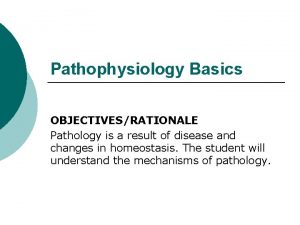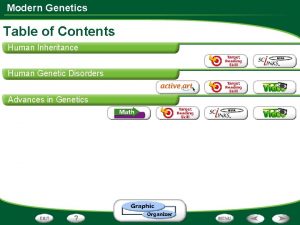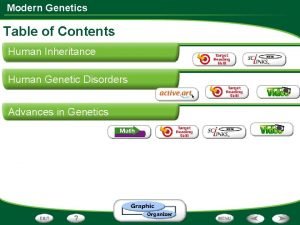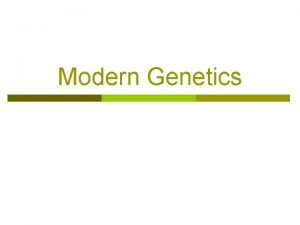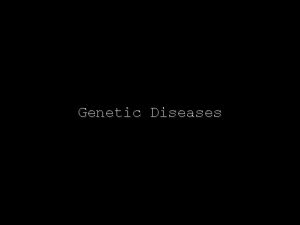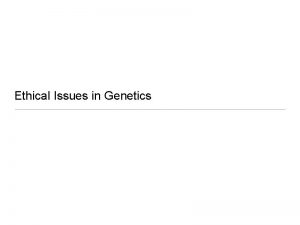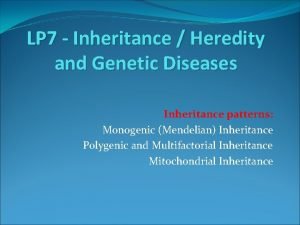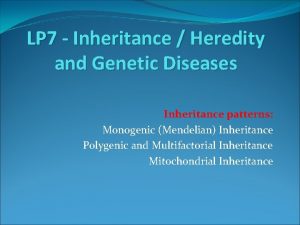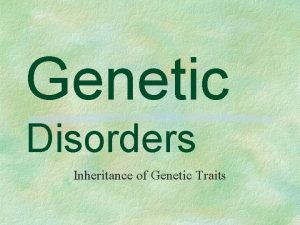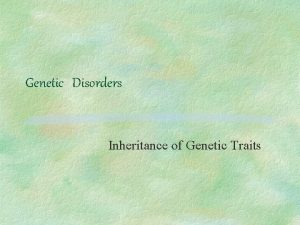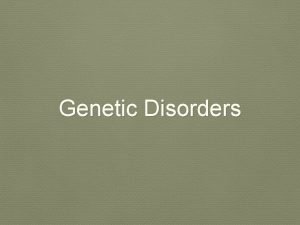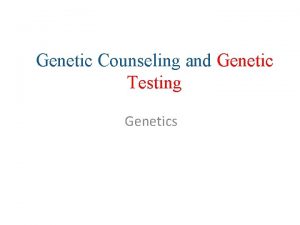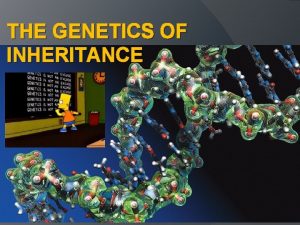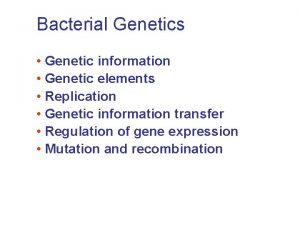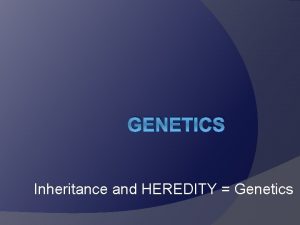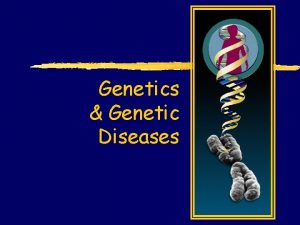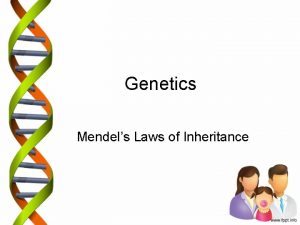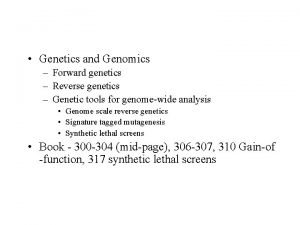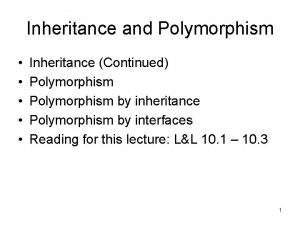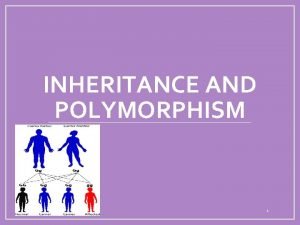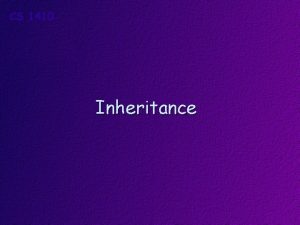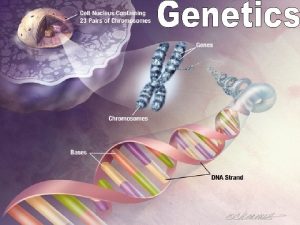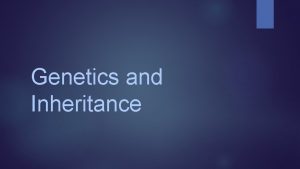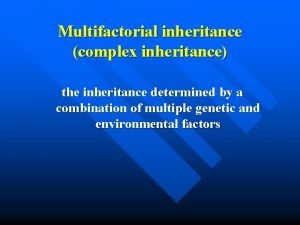Genetics and Genetic Diseases Genetics Study of inheritance

























- Slides: 25

Genetics and Genetic Diseases

Genetics Study of inheritance and human disease p 1860’s – Gregor Mendel p Gene = DNA RNA Proteins (enzymes) permit specific biochemical reactions to occur p Genes determine the structure and function of the human body p

Chromosome p Chromosomes are made of chromatin (DNA)

Human Genome Project p Genome – entire collection of genetic material in a cell p 2001 – rough draft published n n 30, 000 genes 1% carries genes, rest is filler Genomics – analysis of genome p Proteomics – proteins encoded by genes, goal is to understand role of each protein p

Ideogram p Simple cartoon of chromosome n n n P-arm – shorter segment Q – arm – longer segment Bands – show landmarks

Chromosomes 46 chromosomes in a cell, 23 pair p 22 pair – autosomes (body cells) p 23 rd pair – sex chromosomes p n n n XX, XY Undergo meiosis, produce sex cells (gametes) Sperm meets egg = zygote

Genetic Variation p Independent assortment Crossing over p Random p fertilization

Gene Expression – Mendel Complete Dominance Dominant – CC, trait seen p Recessive – cc, trait only seen if both alleles are recessive p CC – homozygous dominant p Cc – heterozygous p cc – homozygous recessive p p Example: Albinism

Gene expression p Codominance – both alleles are dominant n p Incomplete dominance – hybrid n p Ex – blood type A, B, O, AB Pink flowers Sex linked – non-sexual trait carried on X or Y chromosome, sometimes called xlinked since X chromosome is largest n Hemophilia, color blindness

Genetic Mutations p Change in DNA, genetic code n n p Can occur spontaneously Mutagens – cause mutations Carcinogens – cause cancer, viruses Damage to chromosome, deletion can be beneficial

Mitochondrial DNA p p Powerhouse of cell with own circle of DNA Inheritance occurs only through the mother n n sperm mitochondria do not survive during fertilization Codes for only a few important enzymes n carry mutations that produce disease p p p Leber’s hereditary optic neuropathy Parkinsons Alzheimers

Mechanisms of Genetic Disease Single gene diseases p Genetic predisposition – not solely caused by inheritance, but environmental p Non-disjunction – failure of chromosomes to separate p n n Trisomy – triplet of chromosomes (Down syndrome) Monosomy – single chromosome only (Turner syndrome)

Single gene diseases p Cystic fibrosis n n n Recessive Chromosome 7 CFTR gene regulates transfer of sodium ions across cell membrane and serves as chloride ion channel

Phenylketonuria - PKU Recessive p Fail to produce enzyme phenylalanine hydroxylase p n n Converts aa phenylalanine into tyrosine Lack of enzyme results in accumulation and presence of phenylketone in urine which destroys brain tissue. Identified at birth Diet restrictions

Chromosomal diseases Down syndrome, Trisomy 21 p Not inherited, result of nondisjunction p Characterized by p n n n Varying range of mental retardation Distinctive facial appearance Enlarged tongue…

Klinefelter syndrome Nondisjunction of sec chromosomes – XXY p Characteristics p n n n Long legs Enlarged breasts Low intelligence…

Turner Syndrome XO, monosomy female p Characteristics include: p n n n p failure of sex organs maturing dwarfism or short stature cardiovascular defects… Can be treated with hormone therapy, surgery

Prevention and treatment of genetic diseases p Genetic counseling – professional consultation n p Help to determine risk Help evaluate whether offspring have a genetic disorder Offer advice on treatment, care Tools n n n Pedigree Punnett square karyotype

Pedigree p Shows relationships in a family over several generations

Punnett square p Box used to determine the probability of inheriting genetic traits n n Monohybrid dihybrid

Karyotype Used to find chromosomal disorders p Use a sample of cells (cheek, wbc) p Cells in metaphase are stained and photographed p Chromosomes cut and arranged according to size p

Amniocentesis p Fetal cells floating in amniotic fluid are collected using a LARGE syringe

Chorionic Villus Sampling Cell from chorionic villi are collected from area surrounding embryo p Cells are grown in petri dishes, then analyzed p

Treating Genetic Diseases No cure, but some can treat symptoms p Gene therapy p n n Gene replacement – replace abnormal with normal Gene augmentation – normal cells are introduced and add normal proteins

 Chapter 22 genetics and genetically linked diseases
Chapter 22 genetics and genetically linked diseases What causes genetic diseases
What causes genetic diseases The founder effect
The founder effect Genetic programming vs genetic algorithm
Genetic programming vs genetic algorithm Genetic programming vs genetic algorithm
Genetic programming vs genetic algorithm Genetic drift
Genetic drift What is the difference between genetic drift and gene flow
What is the difference between genetic drift and gene flow Human inheritance modern genetics answer key
Human inheritance modern genetics answer key Modern genetics human inheritance answer key
Modern genetics human inheritance answer key Modern genetics human inheritance answer key
Modern genetics human inheritance answer key Molecular genetics section 1 dna the genetic material
Molecular genetics section 1 dna the genetic material Genetics is the study of heredity and variation.
Genetics is the study of heredity and variation. Chapter 7 extending mendelian genetics study guide answers
Chapter 7 extending mendelian genetics study guide answers Lifestyle modern
Lifestyle modern Is athlete's foot communicable or noncommunicable
Is athlete's foot communicable or noncommunicable Section 19-3 diseases caused by bacteria and viruses
Section 19-3 diseases caused by bacteria and viruses Define a primary skin lesion and list three types
Define a primary skin lesion and list three types Chapter 6 musculoskeletal system diseases and disorders
Chapter 6 musculoskeletal system diseases and disorders Chapter 24 sexually transmitted diseases and hiv/aids
Chapter 24 sexually transmitted diseases and hiv/aids Chapter 21 mental health diseases and disorders
Chapter 21 mental health diseases and disorders Chapter 17 reproductive system diseases and disorders
Chapter 17 reproductive system diseases and disorders Chapter 15 nervous system diseases and disorders
Chapter 15 nervous system diseases and disorders Onychomycosis milady
Onychomycosis milady Chapter 8 skin disorders and diseases
Chapter 8 skin disorders and diseases Nail disease
Nail disease Icd 10 morbus hansen
Icd 10 morbus hansen

